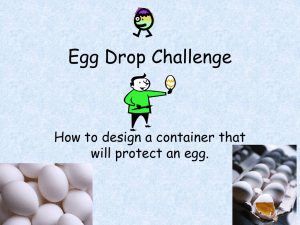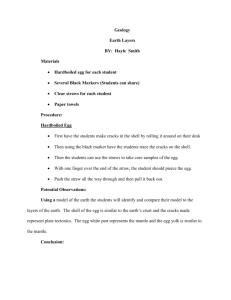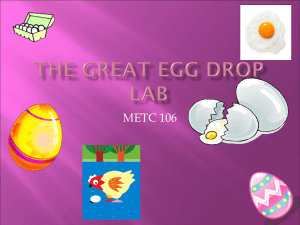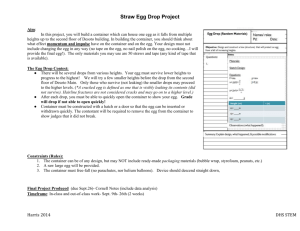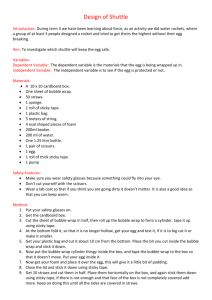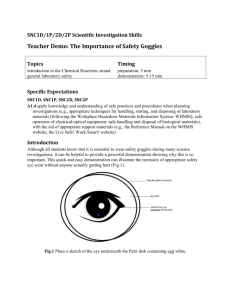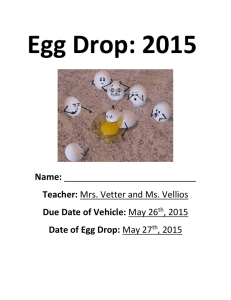Materials
advertisement
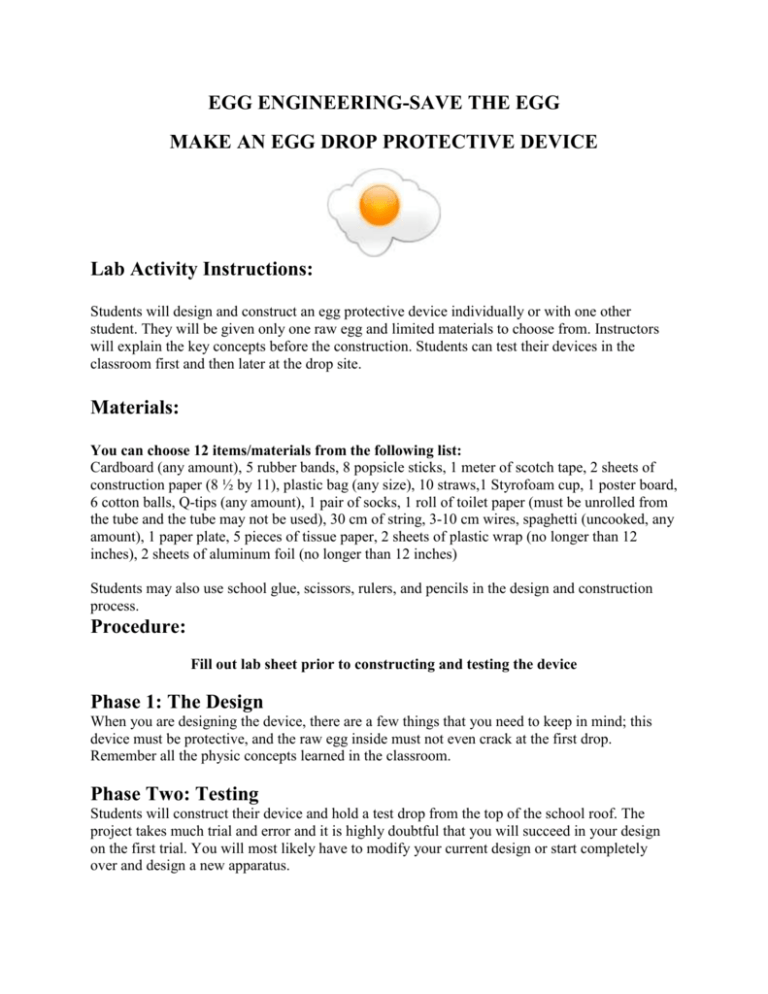
EGG ENGINEERING-SAVE THE EGG MAKE AN EGG DROP PROTECTIVE DEVICE Lab Activity Instructions: Students will design and construct an egg protective device individually or with one other student. They will be given only one raw egg and limited materials to choose from. Instructors will explain the key concepts before the construction. Students can test their devices in the classroom first and then later at the drop site. Materials: You can choose 12 items/materials from the following list: Cardboard (any amount), 5 rubber bands, 8 popsicle sticks, 1 meter of scotch tape, 2 sheets of construction paper (8 ½ by 11), plastic bag (any size), 10 straws,1 Styrofoam cup, 1 poster board, 6 cotton balls, Q-tips (any amount), 1 pair of socks, 1 roll of toilet paper (must be unrolled from the tube and the tube may not be used), 30 cm of string, 3-10 cm wires, spaghetti (uncooked, any amount), 1 paper plate, 5 pieces of tissue paper, 2 sheets of plastic wrap (no longer than 12 inches), 2 sheets of aluminum foil (no longer than 12 inches) Students may also use school glue, scissors, rulers, and pencils in the design and construction process. Procedure: Fill out lab sheet prior to constructing and testing the device Phase 1: The Design When you are designing the device, there are a few things that you need to keep in mind; this device must be protective, and the raw egg inside must not even crack at the first drop. Remember all the physic concepts learned in the classroom. Phase Two: Testing Students will construct their device and hold a test drop from the top of the school roof. The project takes much trial and error and it is highly doubtful that you will succeed in your design on the first trial. You will most likely have to modify your current design or start completely over and design a new apparatus. Phase Three: Actual Drop Raw eggs will be provided at the drop site. The student should bring a small repair kit for their device (tape, scissors, and left-over materials provided, etc.). Be fully prepared and bring all items to the drop site. Hints: • Use light and strong materials • Use simplified apparatuses • Bring a repair kit to the drop site • Don't overcomplicate the design • Don't use heavy materials if at all possible Specifications: ➢ No parachutes are allowed ➢ An area approximately the size of a quarter of the egg must be visible at all times. ➢ Only the allowed materials may be used (listed above). ➢ Only raw, store bought chicken eggs may be used. Your design must not include changing the egg in any way (no tape on the egg, no soaking the egg in vinegar, etc.). ➢ The egg container and all materials must remain intact. For example, no parts – inside or out can fall or break off during flight or impact. ➢ Your egg project must fit on a regular size (8 ½ x 11) sheet of paper (Note that the height of the container is not a factor – it can be “tall” and still fit on the paper). ➢ The container must be able to be opened once we return to the classroom so that we may check on the condition of the egg. The inside materials must be designed to allow raw egg to be easily inserted and removed. Once we return to the classroom, students will complete their lab investigation sheets and reflections. Lab Investigation Sheet Question: _____________________________________________________________________________________ _____________________________________________________________________________________ Hypothesis: _____________________________________________________________________________________ _____________________________________________________________________________________ Background Information: _____________________________________________________________________________________ _____________________________________________________________________________________ _____________________________________________________________________________________ _____________________________________________________________________________________ Variables: Independent: _____________________________________________________________________________________ _____________________________________________________________________________________ Dependent: _____________________________________________________________________________________ _____________________________________________________________________________________ Materials: _____________________________________________________________________________________ _____________________________________________________________________________________ Safety: _____________________________________________________________________________________ _____________________________________________________________________________________ Procedure: _____________________________________________________________________________________ _____________________________________________________________________________________ _____________________________________________________________________________________ _____________________________________________________________________________________ _____________________________________________________________________________________ _____________________________________________________________________________________ Data Tables Conclusion: _____________________________________________________________________________________ _____________________________________________________________________________________ _____________________________________________________________________________________ _____________________________________________________________________________________ _____________________________________________________________________________________ _____________________________________________________________________________________

